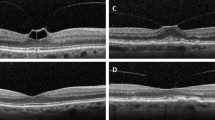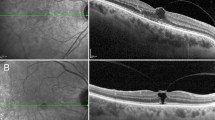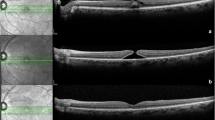Abstract
Purpose
To study the efficacy of a single intravitreal injection of expansile gas as a valuable alternative to current treatment options (conservative, pharmacological, and surgical) in patients with symptomatic, focal vitreomacular traction (VMT).
Patients and methods
This study comprises a retrospective, interventional case series of patients. Twenty eyes in seventeen patients with symptomatic and persisting focal VMT were treated in an outpatient setting with an intravitreal gas injection of 0.2 ml. In 19 eyes, 100% hexafluoroethane (C2F6) was used. One eye received sulfur hexafluoride (SF6). To all but three patients posturing advice was given. Patients were reviewed with a full-eye examination and ocular coherence tomography (OCT) after 14 days and later. The primary outcome measure was the release of VMT on OCT.
Results
In 17 of the 20 (85.0%) treated eyes, a release of VMT was achieved as documented on OCT. The release of VMT was diagnosed during the first month after injection in 11 eyes of 11 patients and within 3 months in 16 eyes of 15 patients. In all but five of our patients, best corrected visual acuity (BCVA) remained stable or improved. In four patients, the progression or development of cataract was the probable cause of the decrease in BCVA. One patient developed a stage II macular hole after injection and needed vitrectomy. None of the treated patients developed retinal breaks.
Conclusion
Intravitreal expansile gas injection could offer a minimally invasive, low-cost alternative treatment in patients with symptomatic, persisting VMT. Additional studies on a larger number of patients are required.
Similar content being viewed by others
Log in or create a free account to read this content
Gain free access to this article, as well as selected content from this journal and more on nature.com
or
References
Johnson MW . Posterior vitreous detachment: evolution and complications of its early stages. Am J Ophthalmol 2010; 149 (3): 371–382.
Rodrigues IA, Stangos AN, McHughDA, Jackson TL . Intravitreal injection of expansile perfluoropropane (C3F8 for the treatment of vitreomacular traction. Am J Ophthalmol 2013; 155: 270–276.
Garcia-Layana A, Garcia-Arumi J, Ruiz-Moreno JM, Arias-Barquet L, Cabrera-Lopez F, Figueroa MS . A review of current management of vitreomacular traction and macular hole. J Ophthalmol 2015; 2015: 809640.
Johnson MW . How should we release vitreomacular traction: surgically, pharmacologically or pneumatically? Am J Ophthalmol 2013; 155 (2): 203–205.
Duker JS, Kaiser PK, Binder S, de Smet MD, Gaudric A, Reichel E et al. The International Vitreomacular Traction Study Group classification of vitreomacular adhesion, traction, and macular hole. Ophthalmology 2013; 120 (12): 2611–2619.
Hikichi T, Yoshida A, Trempe CL . Course of vitreomacular traction syndrome. Am J Ophthalmol 1995; 119 (1): 55–61.
Wu L, Zas M, Berrocal MH, Arevalo JF, Figueroa M, Rodriguez F et al. Anatomical and functional outcomes of symptomatic idiopathic vitreomacular traction. Retina 2016; 36 (10): 1913–1918.
McDonald HR, Johnson RN, Schatz H . Surgical results in the vitreomacular traction syndrome. Ophthalmology 1994; 101: 1397–1402.
Witkin AJ, Patron ME, Castro LS, Reichel E, Rogers AH, Baumal CR et al. Anatomic and visual outcomes of vitrectomy for vitreomacular traction syndrome. Ophthalmic Surg Lasers Imaging 2010; 41: 425–431.
Russell SR, Hageman GS . Optic disc, foveal, and extrafoveal damage due to surgical separation of the vitreous. Arch Ophthalmol 2001; 119: 1653–1658.
Stalmans P, Benz MS, Gandorfer A, Kampik A, Girach A, Pakola S et al. Enzymatic vitreolysis with ocriplasmin for vitreomacular traction and macular holes. N Eng J Med 2012; 367 (7): 606–615.
Quezada Ruiz C, Pieramici DJ, Nasir M, Rabena M, Avery RL . Severe acute vision loss, dyschromatopsia, and changes in the ellipsoid zone on Sd-Oct associated with intravitreal ocriplasmin injection. Retin Cases Brief Rep 2015; 9: 145–148.
Silva RA, Moshfeghi DM, Leng T . Retinal breaks due to intravitreal ocriplasmin. Clin Ophthalmol 2014; 8: 1591–1594.
DaCosta J, Younis S . Transient visual loss and delayed resolution of vitreomacular traction after intravitreal ocriplasmin. Drug Healthcare Patient Saf 2014; 6: 175–178.
Hahn P, Chung MM, Flynn HW Jr, Huang SS, Kim JE, Mahmoud TH et al. Safety profile of ocriplasmin for symptomatic vitreomacular adhesion: a comprehensive analysis of premarketing and postmarketing experiences. Retina 2015; 35 (6): 1128–1134.
Chan CK, Wessels IF, Friedrichsen EJ . Treatment of idiopathic macular holes by induced posterior vitreous detachment. Ophthalmology 1995; 102 (5): 757–767.
Jorge R, Costa RA, Cardillo JA, Uno F, Bonomo PP, Farah ME . Optical coherence tomography evaluation of idiopathic macular hole treatment by gas-assisted posterior vitreous detachment. Am J Ophthalmol 2006; 142 (5): 869–871.
Mori K, Saito S, Gehlbach PL, Yoneya S . Treatment of stage 2 macular hole by intravitreous injection of expansile gas and induction of posterior vitreous detachment. Ophthalmology 2007; 114: 127–133.
Day S, Martinez JA, Nixon PA, Levitan M, Dooner JW, Wong RW et al. Intravitreal sulfur hexafluoride injection for the treatment of vitreomacular traction syndrome. Retina 2016; 36 (4): 733–737.
Ochoa-Contreras D, Delsol-Coronado L, Buitrago ME, Velasco-Barona C, Quiroz-Mercado H . Induced posterior vitreous detachment by intravitreal sulfur hexafluoride (SF6) injection in patients with nonproliferative diabetic retinopathy. Acta Ophthalmol Scand 2000; 78: 687–688.
McHugh D, Gupta B, Saeed M . Intravitreal gas injection for the treatment of diabetic macular edema. Clin Ophthalmol 2011; 5: 1543–1548.
Chan CK, Lin SG, Nuthi AS, Salib DM . Pneumatic retinopexy for the repair of retinal detachments: a comprehensive review (1986-2007). Surv Ophthalmol 2008; 53: 443–478.
Cekic O, Ohji M . Intraocular gas tamponades. Semin Ophthalmol 2000; 15: 3–14.
Johnson MW . Pneumatic displacement of submacular hemorrhage. Curr Opin Ophthalmol 2000; 11 (3): 201–206.
Fang IM, Lin YC, Yang CH, Yang CM, Chen MS . Effects of intravitreal gas with or without tissue plasminogen activator on submacular haemorrhage in age-related macular degeneration. Eye (Lond) 2009; 23 (2): 397–406.
Steel DH, Downey L, Greiner K, Heimann H, Jackson TL, Koshy Z et al. The design and validation of an optical coherence tomography-based classification system for focal vitreomacular traction. Eye (Lond) 2016; 30 (2): 314–324.
Kaiser PK, Kampik A, Kuppermann BD, Girach A, Rizzo S, Sergott RC . Safety profile of ocriplasmin for the pharmacologic treatment of symptomatic vitreomacular adhesion/traction. Retina 2015; 35 (6): 1111–1127.
Shah SP, Jeng-Miller KW, Fine HF, Wheatley HM, Roth DB, Prenner JL . Post-martketing survey of adverse events following ocriplasmin. Ophthalmic Surg Imaging Lasers Retina 2016; 47 (2): 156–160.
Author information
Authors and Affiliations
Corresponding author
Ethics declarations
Competing interests
The authors declare no conflict of interest.
Rights and permissions
About this article
Cite this article
Claus, M., Feron, E. & Veckeneer, M. Pneumatic release of focal vitreomacular traction. Eye 31, 411–416 (2017). https://doi.org/10.1038/eye.2016.231
Received:
Accepted:
Published:
Issue date:
DOI: https://doi.org/10.1038/eye.2016.231
This article is cited by
-
Effect of pneumatic vitreolysis in management of patients with symptomatic focal vitreomacular traction
International Journal of Retina and Vitreous (2022)
-
State of the art und Zukunft der Vitrektomie – Techniken und Instrumente
Spektrum der Augenheilkunde (2018)
-
It’s a gas! Pneumatic release of VMT
Eye (2017)



